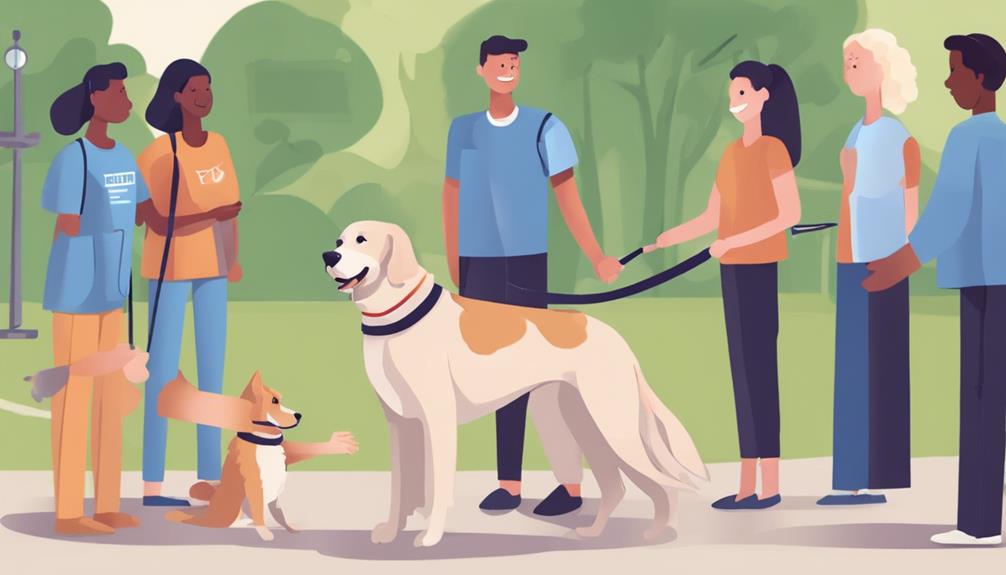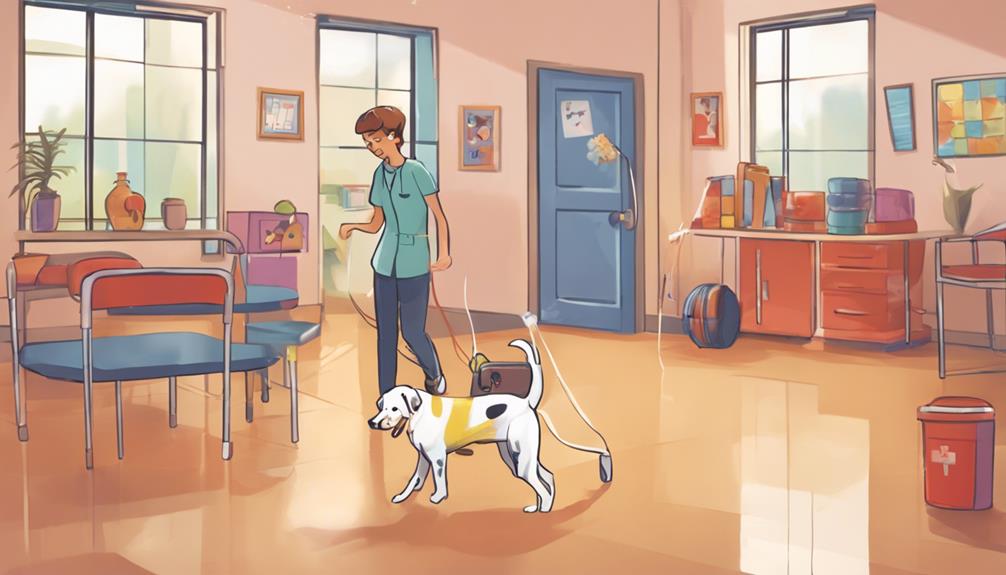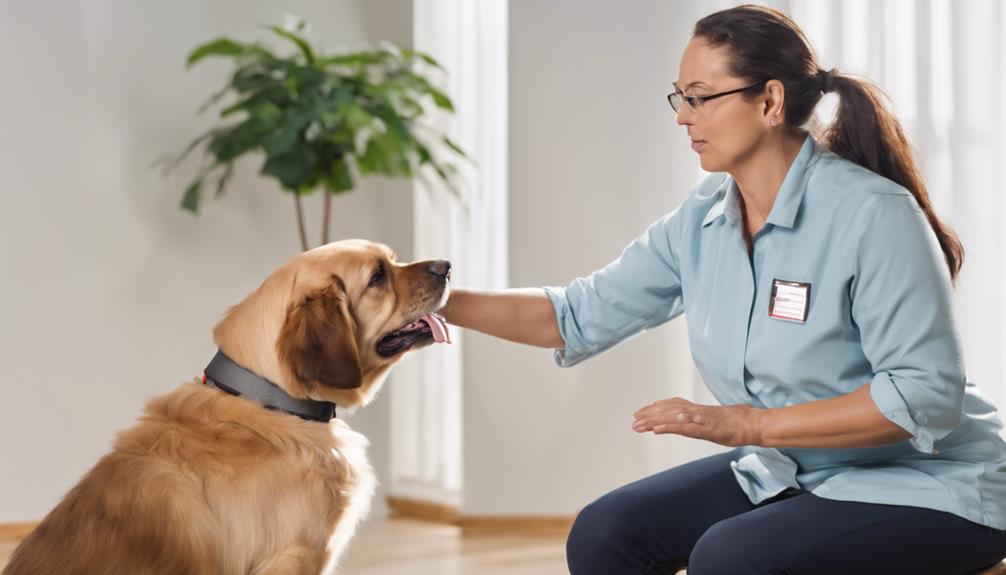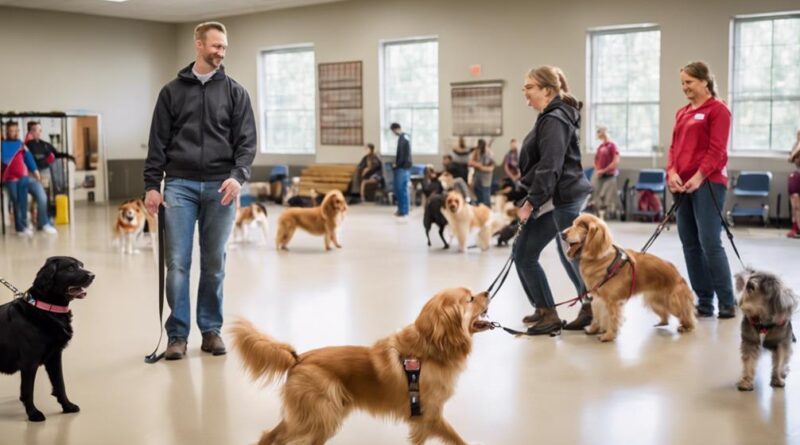13 Essential Tips for Training Therapy Dogs
Master 13 essential tips for training therapy dogs. Begin with basic commands like sit and stay. Use positive reinforcement techniques such as clicker training for faster learning. Socialize your dog early for adaptability. Expose them to different environments to reduce anxiety. Teach calm behaviors through structured routines. Encourage confident interactions with people. Manage stress and anxiety with focus exercises. Maintain regular vet check-ups for overall well-being. Stay patient and consistent to build a strong bond. Each tip plays a crucial role in nurturing your therapy dog's skills and enhancing your relationship.
Start With Basic Commands
To begin training therapy dogs effectively, it's crucial to start with teaching them basic commands such as sit, stay, and come using positive reinforcement techniques. These fundamental commands lay the foundation for more advanced techniques and behaviors. Once your therapy dog has mastered these basic commands, you can move on to more specialized training to enhance their skills and responsiveness to behavioral cues.
Specialty training for therapy dogs involves teaching them advanced skills that are tailored to their role in providing emotional support and comfort. This can include training them to recognize specific behavioral cues from individuals they're interacting with, such as signs of anxiety or distress. By honing these advanced skills, therapy dogs can better assist in various therapeutic settings, from hospitals to schools and nursing homes.
Advanced techniques in training therapy dogs go beyond basic obedience commands and focus on developing their ability to engage with people in a calming and reassuring manner. This can involve teaching them how to maintain a gentle demeanor, respond to different emotional states, and adapt to various environments. By incorporating these advanced techniques into their training regimen, therapy dogs can become invaluable assets in providing comfort and support to those in need.
Use Positive Reinforcement
Positive reinforcement is a highly effective training method for therapy dogs, emphasizing the reward of desired behaviors to encourage their repetition. Clicker training, a popular rewards-based technique, involves using a clicker to signal to the dog the exact moment the desired behavior is exhibited, followed by a treat or praise. This method helps the dog associate the click sound with the reward, speeding up the learning process.
Behavior shaping is another key aspect of positive reinforcement. This technique involves breaking down complex behaviors into smaller, achievable steps. By rewarding the dog for each small step towards the desired behavior, you can gradually shape the final behavior. For instance, if you want your therapy dog to learn to greet patients gently, you can reward sniffing instead of jumping, then reward sitting politely, and finally reward gentle touches.
Motivation techniques play a crucial role in positive reinforcement training. Understanding what motivates your therapy dog, whether it's treats, toys, or praise, is essential for successful training. By using high-value rewards for more challenging tasks and gradually phasing them out as the behavior becomes more solidified, you can keep your dog motivated and engaged in the training process.
Socialize Your Dog Early
When starting to socialize your therapy dog early, expose them to a variety of environments, people, and animals to help them develop positive behaviors and adaptability. Puppy socialization is a critical aspect of training therapy dogs as it lays the foundation for their behavior modification and overall success in their role.
Early socialization helps your therapy dog become comfortable and confident in different situations, reducing the likelihood of fear or aggression towards new environments, individuals, or animals. By exposing them to various stimuli during their critical socialization period, typically between 3 to 14 weeks of age, you can shape their responses and temperaments positively.
Positive interactions during puppy socialization can lead to improved communication skills, better stress management, and increased resilience. Dogs that are well-socialized tend to be more relaxed, confident, and adaptable, making them better equipped to handle the challenges they may encounter during therapy work.
Behavior modification is easier to implement in dogs that have been effectively socialized early on. Exposing your therapy dog to different people helps them learn appropriate ways to interact, while introducing them to other animals can teach them vital communication and social cues. Overall, early socialization plays a crucial role in shaping a therapy dog's behavior and ensuring they can fulfill their role effectively.
Expose to Different Environments
During the critical socialization period, introducing your therapy dog to various environments is essential for their development and adaptability. Exposure benefits your therapy dog by helping them become familiar with different stimuli, sounds, smells, and sights, which can reduce fear and anxiety in unfamiliar situations. By exposing your dog to new environments, you're providing them with opportunities to build confidence and learn how to remain calm and focused amidst distractions.
Regular exposure to new environments also helps in desensitizing your therapy dog to potential triggers, making them better equipped to handle unexpected situations during therapy sessions. It allows them to practice adjusting their behavior based on the environment they're in, enhancing their ability to remain composed in various settings.
When introducing your therapy dog to new environments, start with low-stress locations and gradually progress to busier or more challenging ones. This gradual exposure helps prevent overwhelming your dog and ensures a positive learning experience. Remember to observe your dog's body language and behavior cues during these exposures, as it can provide valuable insights into their comfort level and help you gauge when to introduce them to more stimulating environments.
Incorporating exposure to different environments into your therapy dog's training regimen is crucial for their overall development and success in providing therapy. Through careful and consistent exposure, your therapy dog can become more adaptable, confident, and better prepared to handle the diverse situations they may encounter during their important work.
Teach Calm Behavior
Introducing structured routines that promote relaxation and focus is essential in teaching calm behavior to your therapy dog. By incorporating relaxation techniques and focus exercises into your training sessions, you can help your dog manage anxiety and stress effectively.
One effective relaxation technique is deep breathing exercises. Encourage your dog to take deep breaths by using treats or toys as rewards to promote a sense of calm.
Focus exercises are also crucial in teaching your therapy dog to remain composed in various situations. One popular focus exercise is 'watch me,' where you train your dog to make eye contact with you on command. This not only helps redirect your dog's attention but also fosters a deeper bond between you and your furry companion.
In addition to relaxation techniques and focus exercises, creating a peaceful environment during training sessions can significantly impact your dog's ability to stay calm. Minimize distractions, play soothing music, and maintain a calm demeanor yourself to set the tone for your therapy dog's training.
Consistency is key when teaching calm behavior. Practice these relaxation techniques and focus exercises regularly to help your therapy dog develop effective anxiety management and stress relief strategies. Remember, patience and positive reinforcement are essential in cultivating a calm and well-behaved therapy dog.
Practice Obedience Regularly
Regular practice of obedience commands is essential in maintaining your therapy dog's training and ensuring they respond appropriately in various situations. Consistency is key, repetition is essential to reinforce the training and help your dog retain the commands effectively. Here are some tips to help you practice obedience regularly:
- Set Aside Dedicated Training Time: Schedule regular training sessions to work on obedience commands. Short, frequent sessions are more effective than long, sporadic ones.
- Use Positive Reinforcement: Reward correct responses with treats, praise, or playtime. Positive reinforcement motivates your dog to follow commands willingly.
- Incorporate Distractions: Gradually introduce distractions during training to simulate real-world scenarios. This helps your therapy dog learn to focus amidst various stimuli.
- Maintain Focus: Keep training sessions engaging and interactive to maintain your dog's attention. Use a variety of commands and activities to prevent boredom and promote learning.
Introduce to Various People

To enhance your therapy dog's socialization skills, acquaint them with a diverse range of individuals to promote comfort and confidence in various interactions. When introducing your therapy dog to different people, consider the preferences of therapy dog breeds. For example, Golden Retrievers and Labrador Retrievers are commonly chosen for therapy work due to their friendly and sociable nature. These breeds often excel in interacting with individuals of all ages and backgrounds, making them ideal candidates for therapy dog training.
The benefits of exposing your therapy dog to various people are numerous. By introducing them to individuals with different appearances, behaviors, and movements, you help your dog become more adaptable and less likely to be startled in unfamiliar situations. This exposure can also aid in developing their empathy and understanding of human emotions, which are essential traits for therapy dogs. Additionally, interacting with a diverse group of people can enhance your therapy dog's ability to remain calm and focused in various environments, preparing them for the unpredictable nature of therapy work.
Work on Impulse Control
Enhance your therapy dog's training by focusing on developing their impulse control, a crucial skill for successful therapy work. Impulse control refers to the ability to resist immediate impulses in favor of achieving a long-term goal, making it essential for therapy dogs who must remain calm and focused in various situations. Here are some key strategies to help improve your therapy dog's impulse control:
- Distraction Training: Teach your dog to focus on you amidst distractions by gradually exposing them to different stimuli while practicing commands. Start in a low-distraction environment and gradually increase the level of distractions as your dog improves.
- Impulse Inhibition Exercises: Engage your dog in activities that require them to wait for a signal before acting, such as waiting for permission to eat a treat or enter a room. This helps them learn self-control and patience.
- Focus Exercises: Practice exercises that enhance your dog's ability to maintain focus for extended periods. Simple activities like 'watch me' commands can help improve your dog's attention span and impulse control.
- Self-Control Techniques: Incorporate impulse control games into your dog's training routine. Games like 'leave it' or 'stay' can reinforce self-control and help your dog resist the urge to give in to impulses.
Train for Specific Tasks

To optimize your therapy dog's training, shift your focus towards preparing them for specific tasks that align with their role in therapy sessions. Training for specific tasks involves providing your therapy dog with specialized training to perform the duties required in therapy settings effectively. One crucial aspect of this training is task identification, where you identify the specific tasks your dog needs to perform during therapy sessions.
Start by assessing the needs of the individuals your therapy dog will be assisting. This will help you determine the specific tasks your dog should be trained for. For example, if your therapy dog will be working with individuals with mobility issues, training tasks could include retrieving items, providing support for walking, or even opening doors.
Once you have identified the specific tasks, create a training plan that focuses on teaching your dog the necessary skills. Break down each task into smaller steps and use positive reinforcement techniques to encourage correct behavior. Consistent practice and repetition will help solidify these tasks in your therapy dog's routine.
It is essential to remember that each therapy dog's tasks may vary depending on the context and the individuals they're assisting. Therefore, tailoring your training approach to focus on these specific tasks will help optimize your therapy dog's effectiveness during therapy sessions.
Encourage Confident Interactions
Encouraging confident interactions with your therapy dog involves fostering a welcoming and supportive environment for both the dog and the individuals they're assisting. Building trust and confidence is crucial for successful therapy dog interactions.
Here are four essential tips to help you achieve this:
- Consistent Positive Reinforcement: Utilize treats, praise, and rewards to reinforce positive behaviors during interactions. Consistency in rewarding desired behaviors helps build trust and confidence in your therapy dog.
- Gradual Exposure to Different Environments: Introduce your therapy dog to various settings, sounds, and people gradually. This exposure helps them adapt and feel more confident in unfamiliar situations, leading to more successful interactions.
- Encourage Socialization: Organize controlled socialization opportunities for your therapy dog with different individuals, including children, adults, and the elderly. Positive social interactions help build your dog's confidence in engaging with diverse groups.
- Body Language Awareness: Pay attention to both your therapy dog's body language and the individuals they're interacting with. Understanding visual cues can help you intervene if your dog shows signs of stress or discomfort, ensuring positive interactions and strengthening trust.
Manage Stress and Anxiety

Using proven strategies and techniques, effectively managing stress and anxiety in therapy dogs is essential for maintaining their well-being and enhancing their performance during interactions. Stress management techniques and relaxation exercises play a crucial role in helping therapy dogs stay calm and focused. One effective method is to incorporate regular exercise into their routine, as physical activity can help reduce stress levels and promote relaxation. Additionally, providing them with interactive toys and engaging activities can serve as mental stimulation, aiding in stress relief.
Identifying triggers that cause stress or anxiety in therapy dogs is equally important. By observing their behavior in various situations, you can pinpoint specific triggers and develop appropriate coping strategies. For instance, if a therapy dog shows signs of distress when encountering loud noises, gradual desensitization through exposure to low levels of the noise can help them overcome this fear. Moreover, creating a safe and comfortable environment for therapy dogs, such as a designated quiet space or using calming scents like lavender, can significantly reduce their anxiety levels.
Incorporating these stress management techniques, relaxation exercises, and identifying triggers with corresponding coping strategies into your therapy dog's training regimen can effectively help them manage stress and anxiety, ensuring they're well-prepared and at their best during therapy sessions.
Maintain Regular Vet Check-Ups
Regular veterinary check-ups are crucial for maintaining the health and well-being of therapy dogs. Ensuring your furry companion receives regular check-ups is vital in catching any potential health issues early on and keeping them in optimal condition to perform their therapy duties effectively. Here are four essential reasons why regular vet check-ups are important for therapy dogs:
- Early Detection of Health Issues: Regular vet visits allow for early detection of any health problems that may arise, enabling prompt treatment and preventing the issue from escalating.
- Vaccinations and Preventive Care: Veterinarians can administer necessary vaccinations and provide preventive care measures to protect therapy dogs from common illnesses and diseases.
- Regular Grooming: Veterinarians can also offer advice on regular grooming practices to maintain the cleanliness and overall well-being of therapy dogs, which is essential for their comfort and health.
- Proper Nutrition: Vets can recommend appropriate diets and nutritional plans tailored to the specific needs of therapy dogs, ensuring they receive the essential nutrients to support their active lifestyle and immune system.
Stay Patient and Consistent

To ensure the successful training of therapy dogs, maintaining patience and consistency is key in fostering a strong bond and effective communication between you and your canine companion. Practice consistency by establishing a routine that includes regular training sessions at the same time each day. Dogs thrive on predictability, and by maintaining a consistent schedule, you provide them with a sense of security and understanding of what's expected from them.
Reinforce patience by understanding that each dog learns at its own pace. It's essential to remain calm and composed during training sessions, even if progress seems slow. Dogs can pick up on your emotions, so staying patient will help create a positive learning environment and prevent any feelings of stress or frustration from transferring to your furry friend.
Consistency in commands and rewards is crucial for your therapy dog's training. Use the same verbal cues and hand signals each time you ask your dog to perform a task. Similarly, ensure that rewards are given promptly and consistently to reinforce good behavior. This repetition helps your dog understand what's expected of them and encourages them to continue exhibiting the desired behavior.
Frequently Asked Questions
How Can I Prevent My Therapy Dog From Becoming Overstimulated?
To prevent your therapy dog from getting overstimulated, focus on handling distractions and managing excitement. Remember to keep training sessions short and positive, gradually exposing your dog to different stimuli.
Use positive reinforcement techniques to reward calm behavior and redirect attention when needed. Be mindful of your dog's body language and signs of stress.
Is It Necessary to Train My Therapy Dog for Specific Tasks?
You should consider task specialization when training your therapy dog. By teaching specific tasks, you can tailor their skills to meet the needs of those they'll be assisting.
Utilize training techniques that focus on behaviors like attention, impulse control, and socialization. Behavior modification can help address any challenges your dog may face during therapy sessions.
Remember to also consider mental health considerations to ensure your dog's well-being while performing their important role.
What Do I Do if My Therapy Dog Shows Signs of Stress or Anxiety?
If your therapy dog displays signs of stress or anxiety, it's crucial to address these issues promptly. Pay close attention to behavioral cues and communication signals your dog is giving.
Implement stress management techniques such as deep breathing exercises or gentle massage to help your dog relax. Consistency in addressing these issues and providing a calm environment can greatly improve your therapy dog's well-being and effectiveness in their role.
Can I Socialize My Therapy Dog Too Much?
You can socialize your therapy dog too much. It's crucial to set boundaries and find a balance in their exposure to different environments and interactions.
Over-socialization can lead to stress and burnout for your dog, impacting their ability to provide effective therapy. Ensure that socialization is positive and enriching, keeping an eye on your dog's behavior and adjusting their exposure accordingly to maintain a healthy balance.
How Do I Handle It if My Therapy Dog Doesn't Respond Well to Training Methods?
If your therapy dog isn't responding well to training methods, don't get discouraged. Try alternative approaches like customized techniques based on your dog's needs.
Handling setbacks is part of the training process, so stay patient and persistent. Bonding strategies can also help strengthen your connection with your dog, making training more effective.
Conclusion
In conclusion, training therapy dogs requires patience, consistency, and positive reinforcement. By starting with basic commands, socializing early, and exposing them to various environments, you can help your dog become a confident and well-behaved therapy companion.
Remember to manage stress and anxiety, maintain regular vet check-ups, and always encourage calm and confident interactions. With dedication and effort, you can help your therapy dog make a positive impact on those in need.
